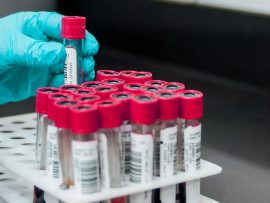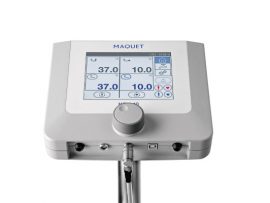Abstract Bleeding and transfusion during cardiac surgery are major sources of complications. Surgery and cardiopulmonary bypass can induce coagulopathy, including platelet dysfunction. Desmopressin has been shown to reduce bleeding and..
Read MoreAbstract Background Coagulopathy frequently complicates venovenous extracorporeal membrane oxygenation (VV ECMO) procedures, yet its underlying mechanism remains elusive. This retrospective study aimed to identify factors contributing to coagulopathy during VV..
Read MoreAbstract Importance Excessive bleeding is a common and prognostically important complication of cardiac surgery. For bleeding related to coagulation factor deficiency, frozen plasma is the most used therapy. Preliminary trials indicate..
Read MoreAbstract Objectives To compare the outcomes of factor eight inhibitor bypassing activity (FEIBA) versus fresh frozen plasma (FFP) as the primary treatment for postoperative coagulopathy in patients undergoing cardiac surgery...
Read MoreAbstract Bleeding and thrombotic complications are major drivers in extracorporeal life support (ECLS) patients’ negative outcomes and are reported in up to 40% of the ECLS-runs [1, 2]. Consumptive coagulopathy..
Read MoreAbstract Physiological hemostasis is a balance between pro- and anticoagulant pathways, and in sepsis, this equilibrium is disturbed, resulting in systemic thrombin generation, impaired anticoagulant activity, and suppression of fibrinolysis,..
Read MoreAbstract Background Primary malignant cardiac tumors are rare in clinic, and surgical resection under cardiopulmonary bypass (CPB) remains the main treatment. The non-physiological perfusion process of CPB leads to contact activation,..
Read MoreAbstract Background Major cardiac surgery related blood loss is associated with increased postoperative morbidity and mortality. Platelet dysfunction is believed to contribute to post-cardiopulmonary bypass (CPB)-induced microvascular bleeding. We hypothesised..
Read MoreAbstract Inherited and acquired coagulopathy are frequently associated with major bleeding in severe trauma, cardiac surgery with cardiopulmonary bypass, and postpartum hemorrhage. Perioperative management is multifactorial and includes preoperative optimization..
Read MoreAbstract Background Coagulopathy following cardiac surgery is associated with considerable blood product transfusion and high morbidity and mortality. The treatment of coagulopathy following cardiac surgery is challenging, with the replacement of..
Read MoreAbstract Background Coagulopathy in cardiac surgery is frequently associated with acquired hypofibrinogenaemia, which can be treated with either purified fibrinogen concentrate (FC) or cryoprecipitate. Because the latter is not purified..
Read MoreAbstract Background Viscoelastic coagulation monitoring is recommended for coagulation management after cardiac surgery, but optimum target values are poorly defined. Aims To determine “to-be-expected” values in rotational thromboelastometry (ROTEM) after..
Read MoreAbstract Hypothermic circulatory arrest (HCA) is an essential procedure during aortic surgery to protect organs; however, hypothermia is believed to cause coagulopathy, which is a major fatal complication. This study..
Read MoreAbstract Viscoelastic hemostatic assay (VHAs) are whole blood point-of-care tests that have become an essential method for assaying hemostatic competence in liver transplantation, cardiac surgery, and most recently, trauma surgery..
Read MoreAbstract Purpose of review Major bleeding in cardiac surgery is commonly encountered, and, until recently, most frequently managed with fresh frozen plasma (FFP). However, a Cochrane review found this practice..
Read MoreAbstract Purpose: Data regarding the incidence of a coagulable state following heat stroke as assessed by Sonoclot signature analysis are limited. Our purpose was to appraise coagulopathy using a dynamic test..
Read MoreAbstract Purpose To develop evidence-based clinical practice recommendations regarding transfusion practices and transfusion in bleeding critically ill adults. Methods A taskforce involving 15 international experts and 2 methodologists used the..
Read MoreAbstract Objectives This study aimed to investigate which factors have a great impact on coagulopathy after cardiopulmonary bypass (CPB) using rotational thromboelastometry (ROTEM). Methods Ninety-eight patients undergoing cardiovascular surgery using..
Read MoreAbstract CARDIAC SURGERY is inherently complex and is associated with a high risk of perioperative bleeding. As such, it is responsible for a disproportionate percentage of annual blood product usage..
Read MoreAbstract Background: Thromboembolism and bleeding contribute to Coronavirus disease 2019 (COVID-19)’s morbidity and mortality and are also frequent complications of venovenous extracorporeal membrane oxygenation (vvECMO). As the interaction of the..
Read MoreAbstract Objective To assess the ratio of non-red blood cell to red blood cell components required to avoid coagulopathy when transfusing large amounts of salvaged blood using laboratory test–guided therapy...
Read MoreAbstract Objectives The authors hypothesized that transfusion of blood products in neonates and infants undergoing high-risk cardiac surgery in the absence of intraoperative coagulation monitoring increases the risk of thrombotic..
Read MoreAbstract Background Moderate (MHCA) versus deep (DHCA) hypothermia for circulatory arrest in has been purported to reduce and bleeding complications, although there are limited data supporting this claim. This study aimed to..
Read MoreAbstract Purpose Hemorrhage is the most common cause of preventable death after trauma. Coagulopathy plays a central role in uncontrolled bleeding and is caused by multiple factors. Extracorporeal Membrane Oxygenation..
Read MoreAbstract Background The administration of blood products during pediatric cardiac surgery is common. We sought to determine if thromboelastography (TEG) is a cost-effective tool to reduce blood product transfusion in..
Read MoreAbstract Objective Aortic surgery often causes massive bleeding due to hypofibrinogenemia. Predicting hypofibrinogenemia is useful for developing a hemostasis strategy, including preparing for blood transfusion. We made a formula for..
Read MoreAbstract Acute aortic syndromes are a distinct group of pathologies involving the wall of the aorta that present acutely and can be potentially fatal unless treated in a timely fashion...
Read MoreAbstract Efforts to reduce blood product transfusions and adopt blood conservation strategies for infants and children undergoing cardiac surgical procedures are ongoing. Children typically receive red blood cell and coagulant..
Read MoreAbstract Blood conservation measures to reduce perioperative blood loss during cardiac surgery have been a subject of focus in recent years. This is due in part to the high cost..
Read MoreAbstract Introduction: Peri-operative monitoring of coagulation is important to diagnose potential cause of hemorrhage, to manage coagulopathy and guide treatment with blood products in patients undergoing cardiac surgery with cardiopulmonary bypass...
Read More














